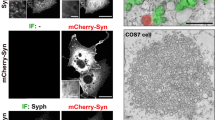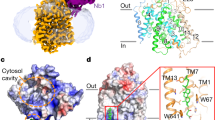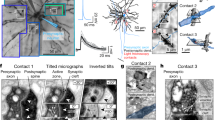Abstract
RESULTS of studies of transport in the nervous system using whole brain and slice preparations suffer from the disadvantage that it is not certain whether they apply to capillary, glial, and/or neuronal cells. Isolation of intact synaptic nerve endings (synaptosomes) has made it possible to investigate transport across synaptic membranes which are free of significant glial contamination1. Synaptosomes can respire and generate ATP and phosphocreatine with glucose as substrate, and glucose metabolism is largely abolished when synaptosomes are ruptured2. The data reported here suggest that carrier mediated sugar transport across synaptic membranes has different characteristics from that seen in brain and brain slices.
This is a preview of subscription content, access via your institution
Access options
Subscribe to this journal
Receive 51 print issues and online access
$199.00 per year
only $3.90 per issue
Buy this article
- Purchase on Springer Link
- Instant access to full article PDF
Prices may be subject to local taxes which are calculated during checkout
Similar content being viewed by others
References
Gray, E. G., and Whittaker, V. P., J. Anat., 96, 79 (1962).
Bradford, H. F., J. Neurochem., 16, 675 (1969).
Diamond, I., and Milfay, D., J. Neurochem., 19, 1899 (1972).
Sols, A., and Crane, R. K., J. Biol. Chem., 210, 581 (1954).
Joanny, P., Corriol, J., and Hillman, P., Biochem. J., 112, 367 (1969).
Bachelard, H. S., J. Neurochem., 18, 213 (1971).
Fishman, R. A., Reiner, M., and Diamond, I., Neurology, 21, 414 (1971).
Diamond, I., and Fishman, R. A., Neurology, 21, 414 (1971).
Cooke, W. J., and Robinson, J. D., J. Neurochem., 18, 1351 (1971).
Junod, A., Lamber, A. E., Stauffacher, W., and Renold, A., J. Clin. Invest., 48, 2129 (1969).
Balázs, R., in Handbook of Neurochemistry (edit. by Lajtha, A.), 3, 1 (Plenum Press, New York, 1970).
Bidder, I. G., J. Neurochem., 15, 867 (1968).
Smyth, D. H., in Membrane Transport and Metabolism (edit. by Kleinzeller and Kotyk, A.), 488 (Academic Press, New York, 1961).
Stein, W. D., The Movement of Molecules Across Cell Membranes, 283 (Academic Press, New York, 1967).
Logan, W. L., and Snyder, S. H., Nature, 234, 297 (1971).
Lowry, O. H., Robert, N. R., Leiner, K. Y., Wu, M. L., Farr, A. L., and Albers, R. W., J. Biol. Chem., 207, 39 (1954).
Rose, S. P. R., in Applied Neurochemistry (edit. by Davison and Dobbing, J.), 332 (F. A. Davis, Philadelphia, 1968).
Author information
Authors and Affiliations
Rights and permissions
About this article
Cite this article
DIAMOND, I., FISHMAN, R. High Affinity Transport of 2-Deoxyglucose in Isolated Synaptic Nerve Endings. Nature 242, 122–123 (1973). https://doi.org/10.1038/242122a0
Received:
Revised:
Issue Date:
DOI: https://doi.org/10.1038/242122a0
This article is cited by
-
Transport and metabolism of glucose by dissociated brain cells: Effects of trypsin
Neurochemical Research (1988)
-
Development of Glucose Oxidation in Isolated Nerve Endings
Nature (1973)
-
The biochemistry of synaptic transmission
Die Naturwissenschaften (1973)
Comments
By submitting a comment you agree to abide by our Terms and Community Guidelines. If you find something abusive or that does not comply with our terms or guidelines please flag it as inappropriate.



